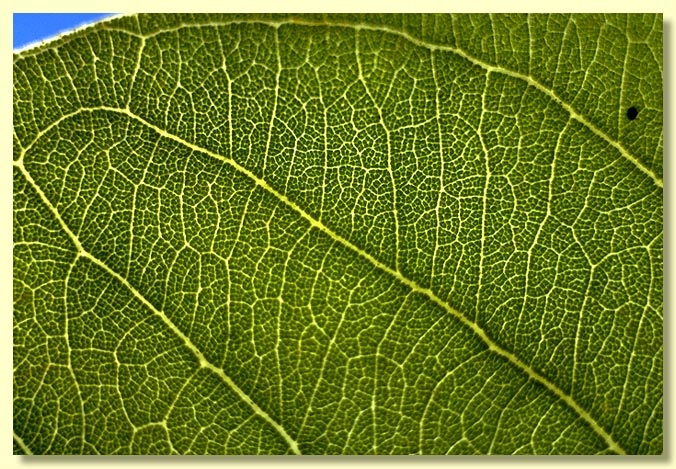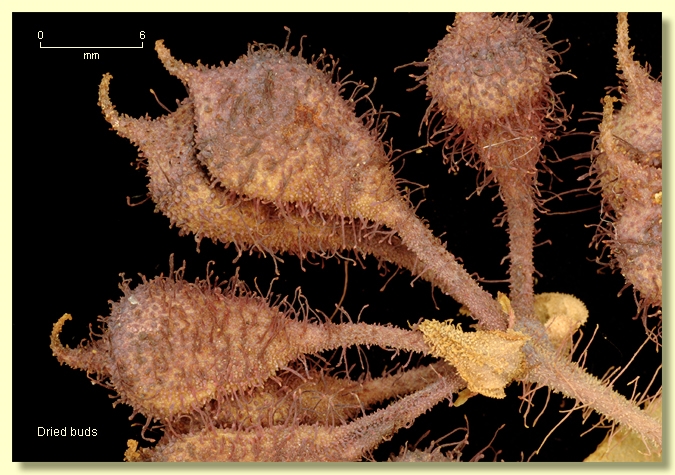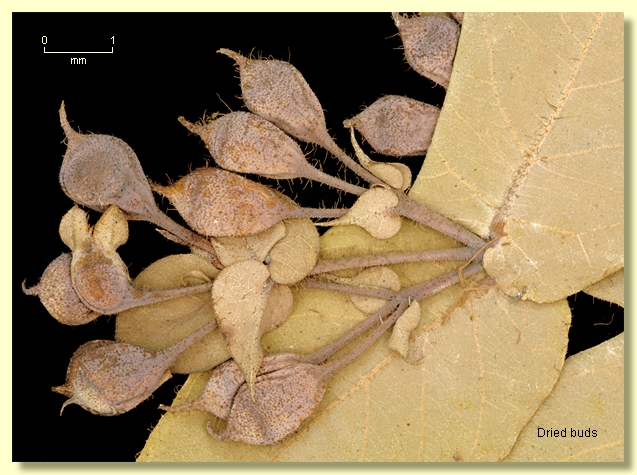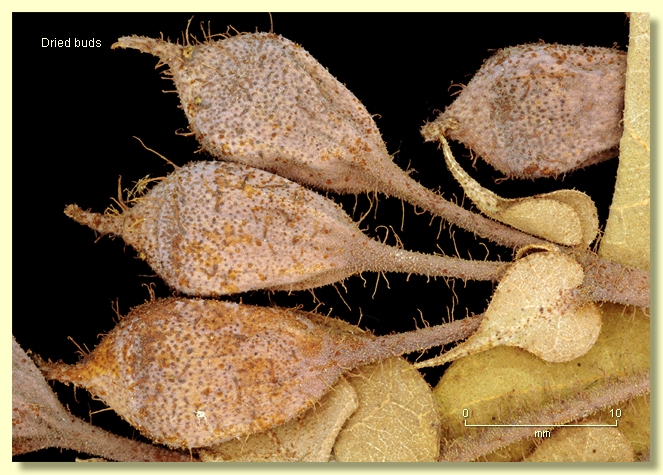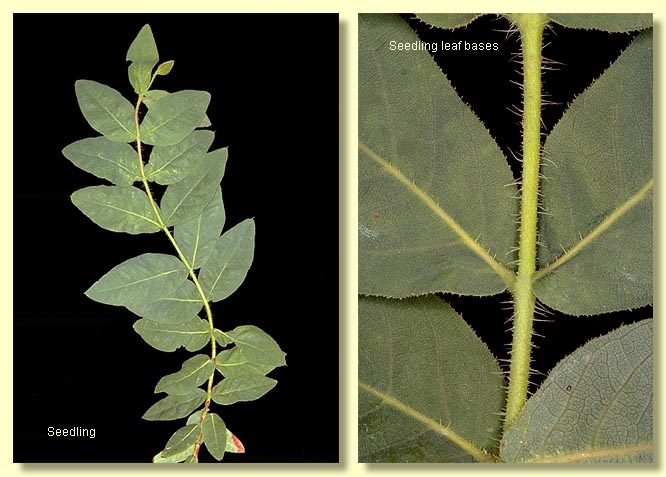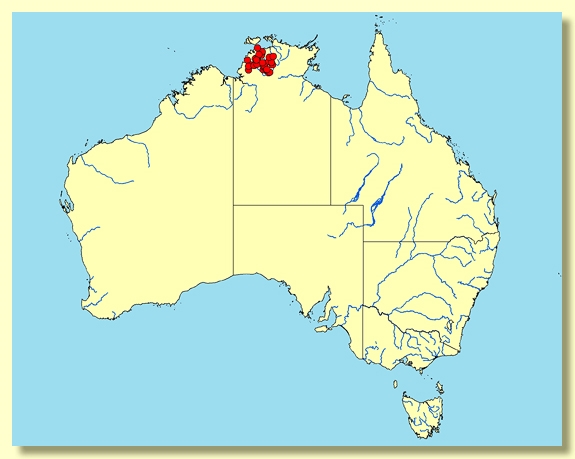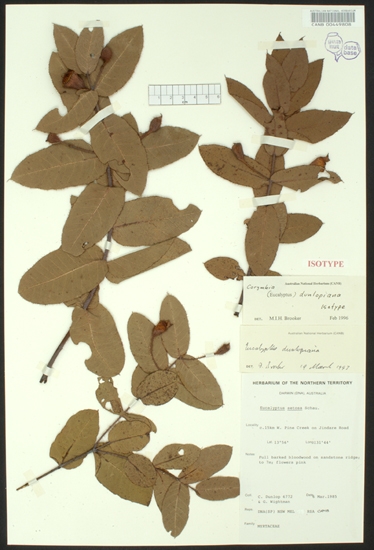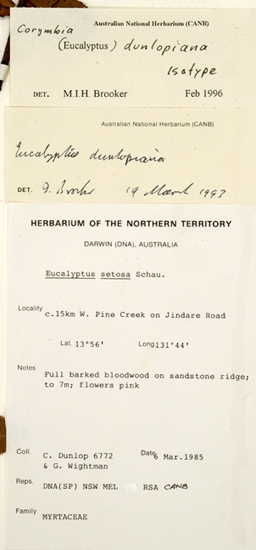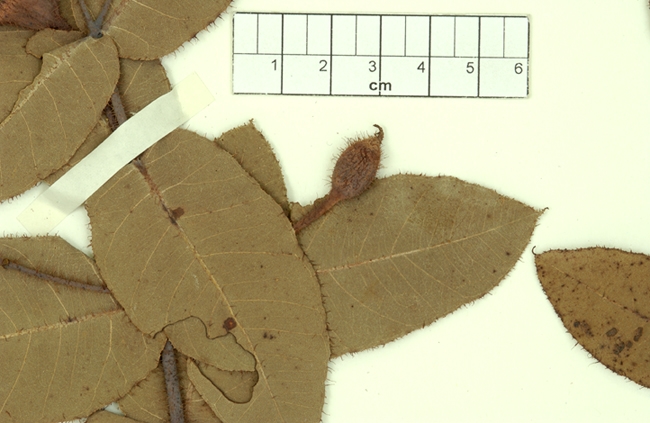Corymbia | Rufaria
Euclid - Online edition
Corymbia dunlopiana
Corymbia dunlopiana K.D.Hill & L.A.S.Johnson, Telopea 6: 354 (1995).
Tree to 7 m tall, branches usually twisted and irregular. Forming a lignotuber.
Bark rough throughout, thick, variably tessellated to flaky, grey to brown over reddish brown.
Branchlets lack oil glands in the pith; smaller branchlets setose with long and short bristle-glands, glaucous or non-glaucous.
Juvenile growth (coppice or field seedlings to 50 cm): stems rounded in cross-section, setose; juvenile leaves opposite, sessile, cordate to elliptical, 4–12.5 cm long, 3–8 cm wide, base rounded or stem-clasping, apex rounded or pointed, dull, green, setose especially on margins and main veins.
Crown of juvenile leaves, opposite, sessile; blade cordate to oblong-lanceolate, 3.5–12 cm long, 2–5.7 cm wide, base amplexicaul, margin entire, apex usually pointed, flat or undulate, concolorous, dull, yellow-green to light green to grey-green, prominently setose with bristle-glands, especially on margins and main veins (rarely the leaves ± glabrous in some populations), side-veins at a wide angle to the midrib (penniveined), reticulation dense to very dense, intramarginal vein present close to margin, oil glands apparently absent from the venation pattern.
Inflorescence terminal compound or solitary umbels in upper leaf axils, peduncles rounded or angled, 0–4 cm long, buds 1 or 3 per umbel, rarely 7, the cluster subtended by small leafy bracts or bracts lacking, conspicuously pedicellate (pedicels 0.4–3.5 cm long). Mature buds pyriform, 1.2–2 cm long, 0.7–1 cm wide, glaucous or non-glaucous, very conspicuously setose with long or short bristle-glands, scar absent (both opercula shed together at flowering), operculum prominently beaked, stamens inflexed, all fertile, anthers versatile, dorsifixed, oblong, dehiscing by longitudinal slits, style long and straight, stigma blunt and papillose, locules (3)4(5), with the vertical ovule rows indistinct on the placentae. Flowers red.
Fruit pedicellate (pedicels 0.4–3.5 cm long), urceolate with a prominent neck which may be slightly flared outwards, 2–3.5 cm long, 2.3–3.2 cm wide, surface rough, disc descending vertically, valves (3)4(5), enclosed.
Seeds brown, 12–17 mm long, ellipsoidal with terminal wing, hilum ventral.
Cultivated seedlings (measured at ca node 10): cotyledons large, reniform; stems rounded in cross-section, densely setose with long bristle-glands; leaves always sessile, opposite for at least 17 nodes, elliptical to ovate or cordate, 4.3–7.5 cm long, 2–4.5 cm wide, base amplexicaul, mid-green, slightly discolorous, sparsely to moderately setose on both surfaces with bristle-glands. Note that the bristle-glands lack simple hairs. The seedlings have flexuose stems.
Flowering has beeen recorded in January, February, April, May, June, July, September, October and December.
A straggly tree endemic to the Top End of the Northern Territory, found in the area from Claravale west of Katherine north to near Daly River extending east to Gimbat, El Sharana and near Jim Jim, in open savannah woodland on rising ground, outcrops and ridges usually with skeletal soil. Corymbia dunlopiana is easily recognised by its crown of small opposite sessile leaves that are usually setose, strongly stalked beaked setose buds, red flowers held clear of the crown, and large urceolate fruit. The inflorescence in C. dunlopiana may be reduced to just one bud or a cluster of three buds in upper leaf axils or a small terminal inflorescence with buds in threes, rarely sevens.
C. dunlopiana is one of a group of northern bloodwood species that are completely rough-barked and have a crown of opposite leaves that are usually sessile. It closest relative is C. chartacea, which has similarly beaked buds and large fruit but differs in the shorter pedicels (always < 1cm long), glabrous leaves that feel papery and white or pink flowers. C. papillosa has similarly setose leaves, smaller buds rarely beaked and much smaller fruit (0.8–1.6 cm wide) than C. dunlopiana. C. ferruginea subsp. ferruginea differs from C. dunlopiana in the buds, which lack the beak, flowers which are white, and the setae on the leaves, branchlets and inflorescence, which are rusty-brown and "stellate".
Until 1995 C. dunlopiana was included within another species, C. setosa, but this is now regarded as occurring further to the south in drier country, from Tennant Creek and Daly Waters east through the Gulf of Carpentaria hinterland to Barcaldine and Musgrave in Queensland. C. setosa, as now circumscribed, has smaller fruit (1.3–2.5 cm wide) than C. dunlopiana, buds with rounded operculum and on shorter pedicels (though there is some overlap in dimensions) and white flowers.
Other species of bloodwood in this opposite-leaved group (C. sphaerica, C. pachycarpa, C. abbreviata, C. ferruginea subsp. stypophylla, C. deserticola and C. zygophylla) occur well to the south and south-west of the distribution of C. dunlopiana in more arid habitats.
MORE ABOUT CORYMBIA
MORE ABOUT RED BLOODWOODS
Corymbia dunlopiana: after Clyde Dunlop (1946–extant 2009). Senior Botanist at the Northern Territory herbarium from 1972 until 2001.
Clyde Dunlop is a keen field botanist and taxonomist with a wide knowledge of the Top End flora including the eucalypts. He joined the Northern Territory Herbarium as a botanist in 1970, stationed in Alice Springs, and moved to Darwin in 1972 replacing Norm Byrnes as officer-in-charge of the herbarium there (DNA). The herbarium, then located at Berrimah, survived the ravages of Cyclone Tracy in 1975 and, in 1988, with Clyde Dunlop supervising, transferred to Palmerston, into what became a model tropical herbarium with excellent controls of collection pests. He retired in 2001 leaving a fully databased, well-curated collection of some 220,000 specimens. Two major reference works on the Top End flora were published under his leadership—Flora of the Darwin Region, vol. 2, and Floodplain Flora.



